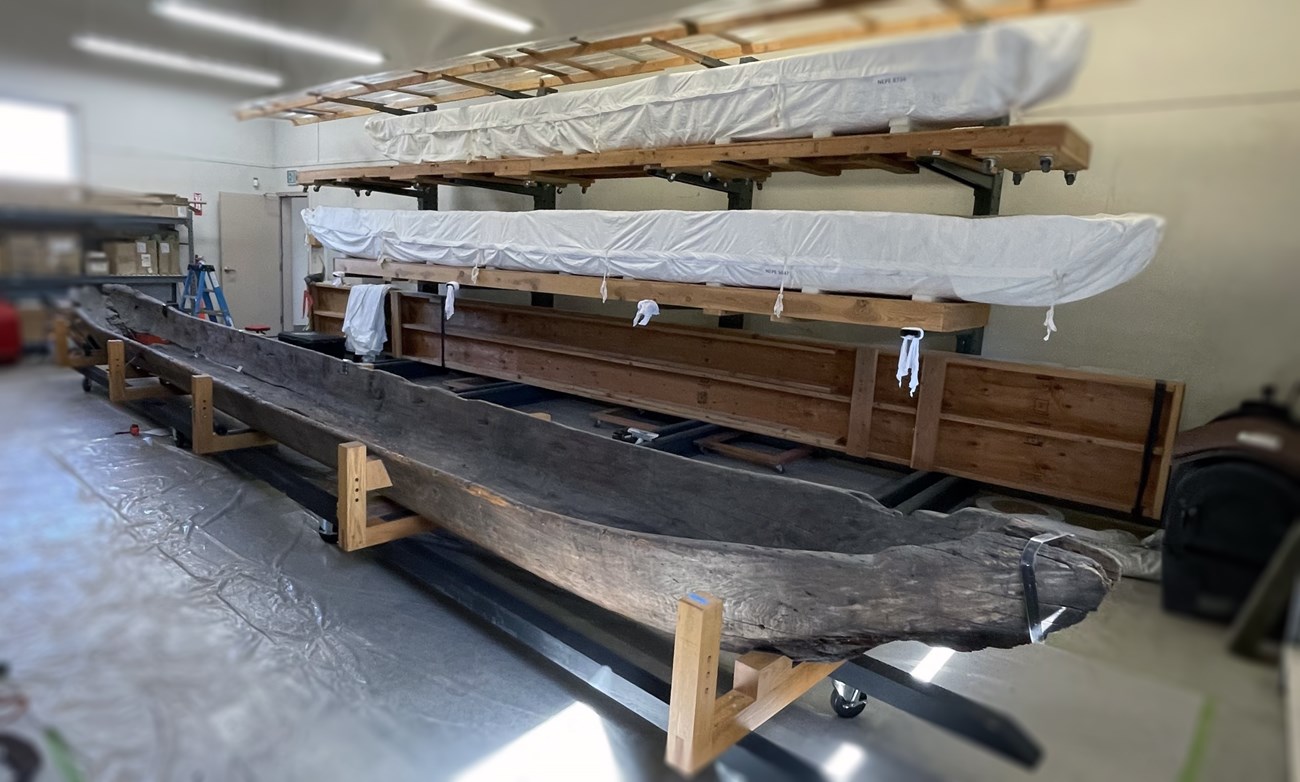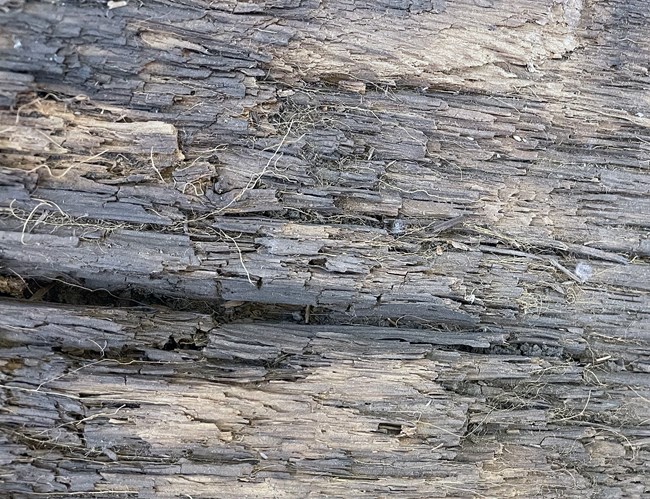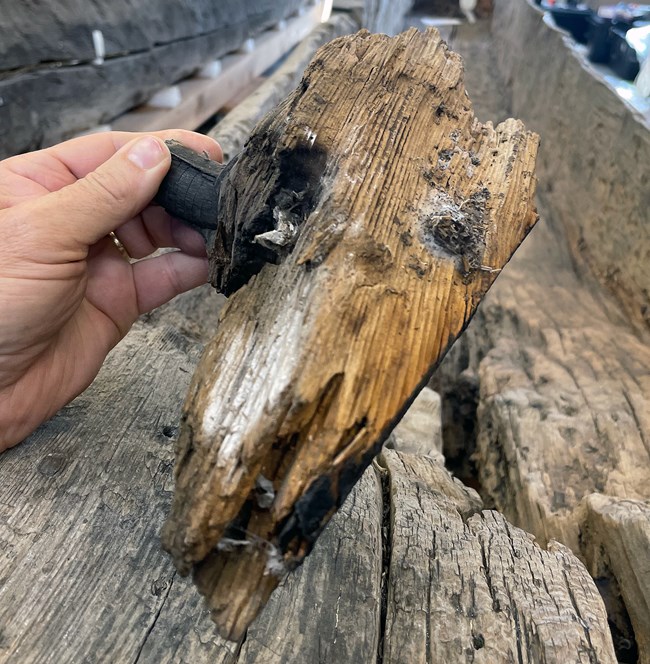Last updated: March 18, 2024
Article
Slowing the Flow of Time: Conservation of Wooden Canoes at Nez Perce National Historical Park

NPS Photo/Curtis Sullivan
Prior to the arrival of horses in the early 1700s, canoes were essential to the daily life of the Nez Perce and other indigenous communities of the Columbia River Plateau. Not only were canoes used for hunting and moving goods, but they also enabled the exchange of ideas and connected communities bounded by rivers and streams. In the collection of Nez Perce National Historical Park there are hand-hewn canoes that are nearly 30 feet long and weigh between 200-500 pounds each. They are some of the few surviving Nez Perce canoes and are exemplars of this traditional craft.
But wooden artifacts face a whole host of threats that cause decay over time including temperature, humidity, and fungus. Over the last twenty years, the park and its tribal partners have taken great strides to stabilize the canoes and slow future deterioration as much as possible.
A Treasured Resource
"The canoes in our collection are culturally important and held in high regard,” explains Kristine Leier, Nez Perce National Historical Park’s Museum Curator. “Not only are they some of the oldest and best documented canoes in the country, but they are a significant resource that helps provide tangible evidence of tribal history, prehistory, and culture. It is crucial that we keep them well preserved for future generations."
Not just utilitarian objects used for fishing, trade, and travel, these canoes are also culturally significant to the Nez Perce. Columbia River Plateau people buried their dead in canoes, conveying the value of these objects. The Crow people of the Northern Plains called the Nez Perce “A-pu-pe,” which means “to paddle.”1 Few of the canoes remain today, making the ones that do even more precious. Their preservation is one of the main reasons the museum program was created in 1965.
Canoes were also essential to the success of the Lewis and Clark expedition, which was a trip by water in the Northwest. Canoe Camp, part of the park today, is where the Corps members made five canoes with the help of local tribes to navigate the Columbia River to the Pacific Ocean.

NPS Photo/Curtis Sullivan
Wood Conservation
The goal of this conservation work was not to restore the canoes to their original appearance, which would require recreating parts of them, but to stabilize the objects and to slow future deterioration. Maintaining as much of the original fabric, or material, of the historic object is an important tenet of preservation. This surviving fabric determines an objects authenticity, or integrity, and a conservator's goal is to slow future deterioration as much as possible.2 Also, marks left by years of use and wear are an important part of an object’s history that conservators try to protect. The Nez Perce canoes have tool marks and early repairs, which tell us about how they were crafted and that they were continually used and reused. In this case, restoring the canoes to their original appearance would compromise the story the objects tell us.But Curtis Sullivan and the team of conservators who went to the park in summer 2023 still had their work cut out for them. Curtis is a Senior Wooden Artifacts Conservator with over twenty years’ experience at the NPS Harpers Ferry Center Museum Conservation Services. He’s been lucky enough to work on historic objects like the Wright Brother’s Flyer and the Statue of Liberty’s torch during his career.

NPS Photo/Curtis Sullivan
This treatment is reversible, another important tenet of preservation. If the goal of preservation is to maintain the integrity of an object, then it stands that any treatments to that object should be reversible.5 In the future, better treatments may be possible, so conservators should be able to return the object to its previous state. If needed in the future, they can flood the same area with alcohol and pull the solvent out, returning the canoes to their previous state.

NPS Photo/Curtis Sullivan
The final step for Curtis and the team was to hand-sew Tyvek bags to cover the newly cleaned and stabilized canoes. These covers will continue to protect the canoes from dust, insects, and rodent damage. Unlike other materials, Tyvek doesn’t hold moisture, which encourages future fungal decay. These bags were designed with Velcro so that Nez Perce museum staff can quickly unwrap them, check their condition, then cover them up again.

NPS Photo/Kristine Leier
Caring for Indigenous Artifacts
The museum collections of the National Park Service tell the story of America, its people, and defining moments in our history. In many cases, the NPS is the steward of indigenous lands and objects – a great responsibility that the NPS has not always lived up to. At Nez Perce National Historical Park, they are striving to reverse that practice, including Tribal partners every step of the way. During the canoe conservation project, the park brought in Tribal youth to get hands-on experience caring for the museum collection. They helped clean the canoes, vacuuming dust and particles that built up over the years.“Though the National Park Service is legally required to preserve the cultural resources under its care, it is also important to understand it is a privilege,” explains Russ Cash, Integrated Resources Division Manager at the park. “The canoes in our care represent a people and culture that have been here longer than our government has been in existence. To have the privilege of caring for the objects of a culture is immense and helps ensure we all have the opportunity to learn from the history of a people.”
Sources
1 Chenoweth, Bob, “walí-mliyas: The Nez Perce NHP Dugout Canoe Collection and Dugout Canoe Use Among Nez Perce Indians,” Journal of Northwest Anthropology, 2008, p. 170.2 See Preservation Terminology, taken from the Secretary of the Interior’s Standards and Guidelines for Historic Preservation.
3 NPS Museum Handbook, Part 1, Appendix N, pg. N16.
4 Personal interview with Curtis Sullivan, January 12, 2024.
5 See “Why should treatments be reversible?,” Chapter 8: Conservation Treatment (nps.gov), National Park Service Museum Handbook, Part 1, pg. 8:4 (2012).
